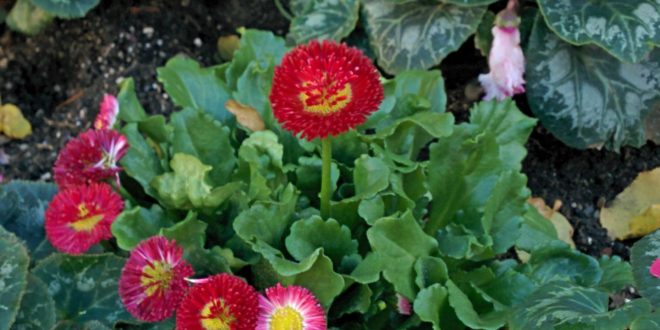English Daisies have long been popular for spring bedding, particularly in mild winter regions. Plants are biennial, usually lasting through one season, but self-seeding to provide future generations. This strain flowers well even in the first year, with little double button flowers of bright rose pink. Removing faded flowers regularly will keep plants blooming well into the summer. Often used to underplant tulips in large public landscapes, these are excellent anywhere in the Sunnyvale garden, especially in containers or tubs. I am growing mine in a converted firepit.
The common or English daisy (Bellis perennis) and the poison daisy (Anthemis cotula) are two varieties that are poisonous to dogs, cats and horses. … If a pet ingests daisies, it is important to call a veterinarian or ASPCA Poison Control facility immediately.
First planted: December 2016
Bought from: Yamagami Nursery
Details
Unknown – Tell us
Water Requirements:
Average Water Needs; Water regularly; do not overwater
Where to Grow:
Unknown – Tell us
Height:
6-12 in. (15-30 cm)
Spacing:
6-9 in. (15-22 cm)
Hardiness:
USDA Zone 4a: to -34.4 °C (-30 °F)
USDA Zone 4b: to -31.6 °C (-25 °F)
USDA Zone 5a: to -28.8 °C (-20 °F)
USDA Zone 5b: to -26.1 °C (-15 °F)
USDA Zone 6a: to -23.3 °C (-10 °F)
USDA Zone 6b: to -20.5 °C (-5 °F)
USDA Zone 7a: to -17.7 °C (0 °F)
USDA Zone 7b: to -14.9 °C (5 °F)
USDA Zone 8a: to -12.2 °C (10 °F)
USDA Zone 8b: to -9.4 °C (15 °F)
Sun Exposure:
Sun to Partial Shade
Danger:
N/A
Bloom Color:
Pink
White/Near White
Bloom Time:
Late Spring/Early Summer
Mid Summer
Late Summer/Early Fall
Mid Fall
Foliage:
Herbaceous
Other details:
Unknown – Tell us
Soil pH requirements:
6.1 to 6.5 (mildly acidic)
6.6 to 7.5 (neutral)
Patent Information:
Non-patented
Propagation Methods:
From seed; direct sow outdoors in fall
From seed; sow indoors before last frost
From seed; direct sow after last frost
Seed Collecting:
Allow seedheads to dry on plants; remove and collect seeds








